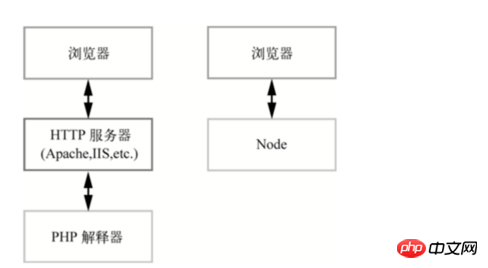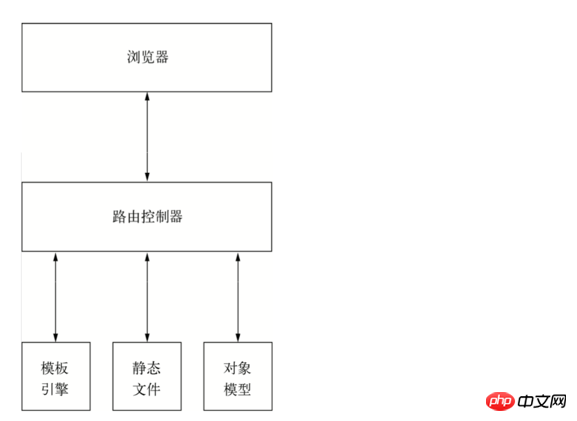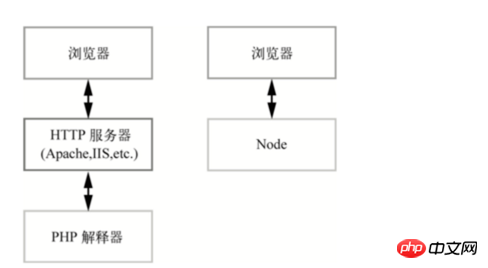 Web Front-end
Web Front-end
 JS Tutorial
JS Tutorial
 How much do you know about web development with Nodejs? An article to let you understand nodejs web development
How much do you know about web development with Nodejs? An article to let you understand nodejs web development
How much do you know about web development with Nodejs? An article to let you understand nodejs web development
This article lets us understand nodejsThe process of web development. Everything you want to know is here. HTML pages are dynamically generated by the server. Let’s take a look at this article.
First, the purpose of Node.js, PHP, Perl, ASP, and JSP is to realize dynamic web pages, which means that the server dynamically generates HTML pages. The reason for this is that static HTML has very limited scalability and cannot effectively interact with users. (Tutorial recommendation: node.js Chinese Reference Manual)
Software engineering is decomposed into three levels: model, view and controller.
#The model is the implementation of objects and their data structures, usually including database operations.
View represents the user interface, which is usually the organizational structure of HTML in a website.
The controller is used to process user requests, data flows, complex models, and pass output to the view.
Preparation work
1. Use the http module
post Request:
var http = require('http');
var querystring = require('querystring');
var server = http.createServer(function(req, res) {
var post = '';
req.on('data', function(chunk) { post += chunk;
});
req.on('end', function() {
post = querystring.parse(post);
res.write(post.title);
res.write(post.text);
res.end();
}); }).listen(3000);
So compared to PHP, if you want to use nodejs to directly develop a website using the http module, you must implement everything manually. Students who want to learn node.js can go to PHP Chinese website node.js video tutorial column
2. Express framework
The only web development framework recommended by nodejs
In addition to providing a higher-level interface for the http module, it also implements many functions, including:
-Routing control
-
-Model parsing support
-Dynamic view
-User session
- CSRF protection
- Static file service
- Error controller
- Access log
- Cache
- Plug-in support
Quick Start
1. Install Express
$ npm install -g express
2. Create a project
$ express -t ejs microblog $ cd microblog && npm install
3. Start the server
$ node app.js
3. Routing control
1. Working principle
When accessing http://localhost:12138, the browser will send a request to the server
-
The app parses the path of the request and calls the corresponding logic
There is a line in app.js that is app.get('/', routes.index), its function is The GET request with the specified path / is processed by the routes.index function
routes.index calls the view template index through res.render('index',{title: 'Express'}), Pass the title variable
The final view template generates an HTML page and returns it to the browser
After the browser receives the content, it analyzes and finds that the Get /stylesheets/style.css, so the server will send a request again.
There is no routing rule in app.js that points to /stylesheets/style.css, but the app is configured through app.use(express.static(__dirname '/public')) Static file server, so /stylesheets/style.css will be directed to the file public/stylesheets/style.css in the subdirectory of the directory where app.js is located, and return the style content to the client

2. Create routing rules
Open app.js and add a line after the existing routing rule app.get('/', routes.index)
app.get(‘/hello’, routes.hello);
改 routes/index.js, 加 hello 函数:
exports.index = function(req, res) {
res.render('index', { title: 'Express' });
};
exports.hello = function(req, res) {
res.send('The time is ' + new Date().toString());
};REST style routing rules
4. Template engine
1. What is a template engine
Template Template Engine is a tool that generates HTML from page templates according to certain rules. The function of the template engine is to combine the page template with the data to be displayed to generate an HTML page.
It can run on the server side or on the client side
The mainstream is to run the template engine on the server
In the MVC architecture, the template engine is included on the server side and controls After the server gets the user request, it gets the data from the model and calls the template engine.
The template engine takes the data and page template as input, generates the html page, and then returns it to the controller
is handed back by the controller Give the client
the location of the template engine in mvc:

The ejs tag system is very simple, with 3 tags:
- - : js code
- - : Display the content of replaced html special characters
- : Display the original html content
The above is all the content of this article about nodejs for web development (more For more details, go to the PHP Chinese website node.js Chinese Reference Manual). If you have any questions, you can leave a message below.
【Editor’s recommendation】
Detailed introduction to Javascript modularization
What is the front-end template? Introduction to the principles and examples of front-end templates
The above is the detailed content of How much do you know about web development with Nodejs? An article to let you understand nodejs web development. For more information, please follow other related articles on the PHP Chinese website!

Hot AI Tools

Undresser.AI Undress
AI-powered app for creating realistic nude photos

AI Clothes Remover
Online AI tool for removing clothes from photos.

Undress AI Tool
Undress images for free

Clothoff.io
AI clothes remover

AI Hentai Generator
Generate AI Hentai for free.

Hot Article

Hot Tools

Notepad++7.3.1
Easy-to-use and free code editor

SublimeText3 Chinese version
Chinese version, very easy to use

Zend Studio 13.0.1
Powerful PHP integrated development environment

Dreamweaver CS6
Visual web development tools

SublimeText3 Mac version
God-level code editing software (SublimeText3)

Hot Topics
 Is nodejs a backend framework?
Apr 21, 2024 am 05:09 AM
Is nodejs a backend framework?
Apr 21, 2024 am 05:09 AM
Node.js can be used as a backend framework as it offers features such as high performance, scalability, cross-platform support, rich ecosystem, and ease of development.
 What is the difference between npm and npm.cmd files in the nodejs installation directory?
Apr 21, 2024 am 05:18 AM
What is the difference between npm and npm.cmd files in the nodejs installation directory?
Apr 21, 2024 am 05:18 AM
There are two npm-related files in the Node.js installation directory: npm and npm.cmd. The differences are as follows: different extensions: npm is an executable file, and npm.cmd is a command window shortcut. Windows users: npm.cmd can be used from the command prompt, npm can only be run from the command line. Compatibility: npm.cmd is specific to Windows systems, npm is available cross-platform. Usage recommendations: Windows users use npm.cmd, other operating systems use npm.
 Is nodejs a back-end development language?
Apr 21, 2024 am 05:09 AM
Is nodejs a back-end development language?
Apr 21, 2024 am 05:09 AM
Yes, Node.js is a backend development language. It is used for back-end development, including handling server-side business logic, managing database connections, and providing APIs.
 What are the global variables in nodejs
Apr 21, 2024 am 04:54 AM
What are the global variables in nodejs
Apr 21, 2024 am 04:54 AM
The following global variables exist in Node.js: Global object: global Core module: process, console, require Runtime environment variables: __dirname, __filename, __line, __column Constants: undefined, null, NaN, Infinity, -Infinity
 How to connect nodejs to mysql database
Apr 21, 2024 am 06:13 AM
How to connect nodejs to mysql database
Apr 21, 2024 am 06:13 AM
To connect to a MySQL database, you need to follow these steps: Install the mysql2 driver. Use mysql2.createConnection() to create a connection object that contains the host address, port, username, password, and database name. Use connection.query() to perform queries. Finally use connection.end() to end the connection.
 Is there a big difference between nodejs and java?
Apr 21, 2024 am 06:12 AM
Is there a big difference between nodejs and java?
Apr 21, 2024 am 06:12 AM
The main differences between Node.js and Java are design and features: Event-driven vs. thread-driven: Node.js is event-driven and Java is thread-driven. Single-threaded vs. multi-threaded: Node.js uses a single-threaded event loop, and Java uses a multi-threaded architecture. Runtime environment: Node.js runs on the V8 JavaScript engine, while Java runs on the JVM. Syntax: Node.js uses JavaScript syntax, while Java uses Java syntax. Purpose: Node.js is suitable for I/O-intensive tasks, while Java is suitable for large enterprise applications.
 How to deploy nodejs project to server
Apr 21, 2024 am 04:40 AM
How to deploy nodejs project to server
Apr 21, 2024 am 04:40 AM
Server deployment steps for a Node.js project: Prepare the deployment environment: obtain server access, install Node.js, set up a Git repository. Build the application: Use npm run build to generate deployable code and dependencies. Upload code to the server: via Git or File Transfer Protocol. Install dependencies: SSH into the server and use npm install to install application dependencies. Start the application: Use a command such as node index.js to start the application, or use a process manager such as pm2. Configure a reverse proxy (optional): Use a reverse proxy such as Nginx or Apache to route traffic to your application
 Can nodejs write front-end?
Apr 21, 2024 am 05:00 AM
Can nodejs write front-end?
Apr 21, 2024 am 05:00 AM
Yes, Node.js can be used for front-end development, and key advantages include high performance, rich ecosystem, and cross-platform compatibility. Considerations to consider are learning curve, tool support, and small community size.





